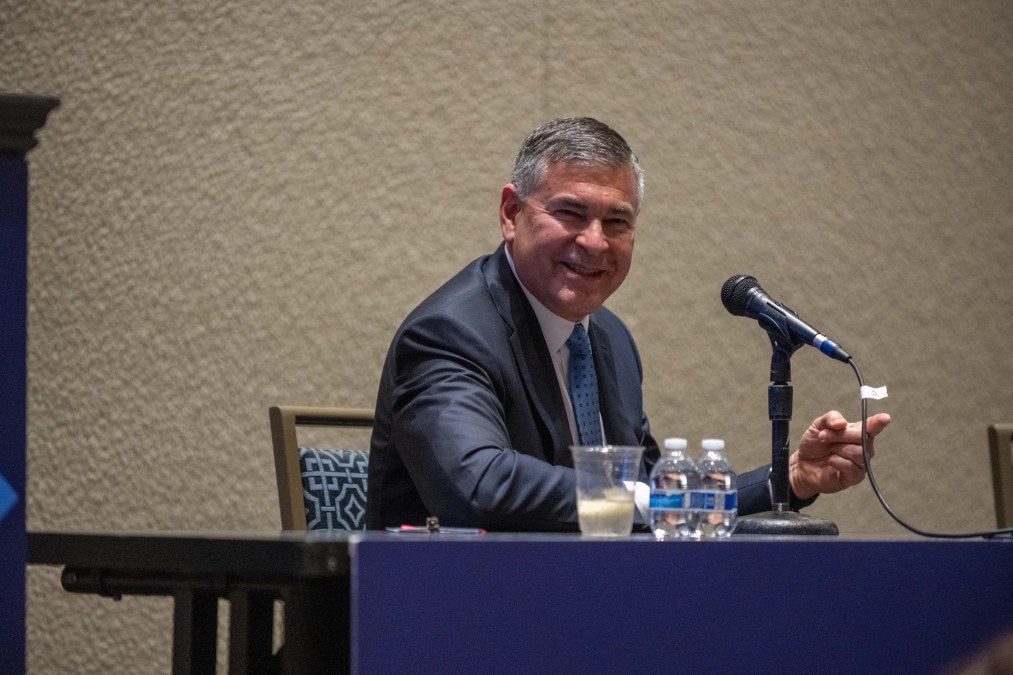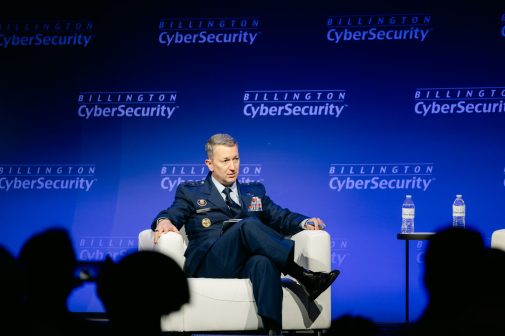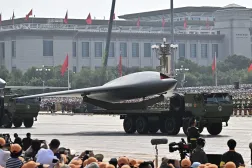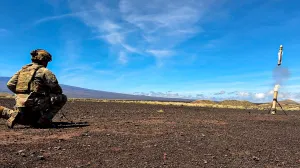Pentagon’s departing DIU director reflects on his legacy — and what’s next

Among multiple items he’s prioritizing as his tenure leading the Pentagon’s Defense Innovation Unit comes to a close, Mike Brown says he’s being deliberate about advising others.
“Whatever I can do in my last weeks to help the service members — making sure their performance reviews are done, whatever we can do for promotion boards, any assistance I can provide people given my commercial experience my whole career in Silicon Valley before leading DIU with career advice — I will,” Brown told FedScoop in a recent interview.
Formed by then-Defense Secretary Ash Carter in 2015, DIU was designed to leverage the investment and speed of advances in commercial technologies to ultimately help strengthen the military and enable more rapid deployments of cutting-edge capabilities. The unit has expanded since then and established outposts to promote further innovation in a few of the United States’ key technology hubs.
After steering DIU for the last nearly four years, Brown opted not to extend his term — and recently announced plans to exit in September.
In a recent conversation with FedScoop, the CEO-turned-federal director reflected on some of what defined his service at DIU — the great, and the not-so-good parts — and also shared new details about his plans for his final days there and what’s to come.
“I want to continue in the same area of national security and technology. I think it’s a nexus that’s going to be increasingly important as we look out over the next couple of decades,” he noted.
Changing the game
DIU has experimented with and helped field dozens of technologies for DOD components under Brown’s leadership.
“We’ve brought 50 different capabilities to the military, so it’s kind of hard to pick favorites. But I’ll give just a couple of examples, rather than saying they are favorites,” Brown said. “What we’ve done with small drones certainly would be up there.”
Through the unit’s Blue UAS program, officials are helping vet and scale more unmanned aerial systems (UAS), or drones, from U.S. and allied countries for DOD use. It was created with the intention of becoming the most efficient method for government validation of UAS available for commercial systems, though it isn’t the only one.
“Being able to harmonize some requirements across the military and provide those on a [General Services Administration] schedule so that, across the federal government, other parts of the government can buy these cyber-hardened, qualified drones, and support [American] and allied suppliers is critically important,” Brown noted — particularly “because China has the jump here, with the world’s largest market share of small drones.”
In the director’s view, DIU also has “pioneered the concept that we don’t have to build our own rockets.” Considering the commercialization of space, he said it’s critical for the government to be able to buy payload space and launch small satellites, sensors and other national security devices as-a-service.
Further, the unit has enabled a number of artificial intelligence-driving projects to bring sensor fusion together — including providing the North American Aerospace Defense Command (NORAD) and U.S. Northern Command (NORTHCOM) with “a better picture of the airspace over North America and being able to give the president more time should he ever have to make a decision about what’s happening over airspace and whether we need to respond,” Brown said. “We’ve dramatically reduced the amount of time that it takes to understand what’s going on and correlate different sensors.”
DIU officials have also promoted more use of digital wearables by military personnel and department leadership to improve how they capture and benefit from health indications.
“So, I’m wearing a commercial digital watch — and, or a ring,” Brown said, pointing to the device on his wrist.
“Most of the problems that we have to solve in the military, except for the very last step — which could be some kinetic action, like blowing something up — are issues that the commercial world is facing.”
Mike Brown, Director of DIU
Working with Philips Healthcare, DIU is combining that data from individuals like Brown and using the heaps of data points collected to detect COVID-19 in the military “up to 72 hours in advance of my ever feeling a symptom,” with 75% accuracy, the director noted.
“So it’s a completely new way to change the game on readiness — not just is the equipment ready and am I trained on the equipment — but am I ready, as a human?” he said.
Many solicitations for company-built solutions to military problems were posted under the director’s purview. “A lot of them now are focused on our newest portfolio, which is energy,” Brown added.
The U.S. military is the world’s largest consumer of energy, he said.
Aligned with the priorities of the current administration, DIU recently launched a few projects associated with energy resilience. Officials involved want to essentially take what the commercial sector is doing to improve energy conservation, like developing new fuels, and incorporate those elements into the military.
“For example, right now we’re converting a lot of the Army vehicles and trucks to be hybrids, because we found that 80% of the time that they’re in use they’re idling somewhere. They’re not going somewhere, but just keeping someone cool or warm. And that, of course, wastes fuel and creates a signature that adversaries can attack. So we’re busy with that tactical vehicle hybridization,” Brown said.
Level up
DIU roots trace back to DIUx, the DOD’s original — and experimental — innovative acquisition team. In 2018, it was made a permanent part of the Pentagon, and the “x” in its name was dropped. From his perch leading requests for and releases of commercial technologies for DOD since then, Brown sees a variety of ways DIU can “level up” again, in the near term.
“One is, we want to make sure that we’re creating a much closer connection between what we’re doing at DIU and mainstream acquisition,” he said.
The unit is now engaging in meetings with all of the program executive officers for each service. As they refine procurement approaches, Brown wants to see each of those PEO leaders turn to the commercial market first, “because most of the problems that we have to solve in the military, except for the very last step — which could be some kinetic action, like blowing something up — are issues that the commercial world is facing.” Problems associated with cybersecurity, fusing sensors, or computer vision, for instance, are “being solved by the commercial world, frankly, in a much bigger volume,” he noted.
The director added: “We’re participating in industries in some cases that we’ve created, but just as a regular customer. So, we need to make sure that we are connecting what we’re doing in the military to all of that incredible commercial activity that’s happening around us.”
DIU should also conduct much more outreach to provide U.S. venture capitalists and entrepreneurs with market signals about the capabilities and quantities associated with technology the military urgently requires.
“And then we need to be reinforcing that with more and larger production volume contracts. Some of what DIU is doing is providing that today. The 100 vendors we’ve introduced through DIU have $3.7 billion of follow-on revenue, but that’s not very much relative to what DOD buys,” Brown said.
One counter-drone technology supplier DIU worked with recently landed a billion-dollar follow-on contract from Special Forces Command. And another vendor the unit collaborated with to provide predictive maintenance for aircraft just won a half-billion-dollar follow-on contract from the Missile Defense Agency, “because their platform can provide synthetic trajectories of hypersonic missiles,” Brown noted, but there should be much more.
The soon-to-exit director added that DIU also needs to work more closely with companies in allied nations, so that “we’re getting the best of technology available globally — not just what’s available in the U.S. — to support our warfighters.”
Up next
Brown’s government service did involve some frustrations, rough points and controversy.
In 2021, he formally requested for his name to be withdrawn from consideration by President Joe Biden to become the undersecretary of defense for acquisition and sustainment following an inspector general’s investigation into allegations of nepotism pushing ethical boundaries as director.
The reasoning Brown gave for removing himself as the nominee was that he did not want delays posed by an ongoing inspector general investigation regarding allegations of wrongdoing to hold up the process for that important procurement position.
“The allegations made by one former employee is that we misused our hiring authority. I have complete confidence that those are going to be resolved positively — but unfortunately, the inspector general takes a very long time,” Brown said.
The allegations came from Bob Ingegneri, who was DIU’s Chief Financial Officer from May 2019 to June 2020, and became public shortly after Biden’s nomination of Brown to be the Pentagon’s head of acquisition.
In an official complaint to the DOD’s primary oversight arm, Ingegneri alleged that Brown abused his top role to hire people close to him and also increase payments to certain defense contractors.
“Those allegations came over a year ago. I still don’t know when the inspector general is going to complete their work, but I’m looking forward to it being completed so that we can put this behind us,” Brown told FedScoop, adding, “I have confidence that we’ve done everything at DIU according to the way we should have and I don’t have any qualms about what they might be finding in their work.”
Preparing for Brown’s impending departure, the Pentagon last week officially announced that it is accepting applications for a new director until August 15.
“Mike has had a tremendous impact on technology adoption and development these past four years,” Brown’s boss — Under Secretary of Defense for Research and Engineering Heidi Shyu — said in the official statement. “Under his tenure, barriers to entry for commercial companies have been lowered and numerous key technologies have been deployed to the warfighter. I am sure that wherever he next goes, he will be very successful. Our new director will certainly have very large shoes to fill.”
Regarding what’s next for his career, Brown confirmed he will be reflecting on improvements he can help make associated with commercial defense technologies from outside of the department.
“So, I’ve agreed with the Hoover Institute at Stanford University to be a visiting scholar next year,” he said. “I’m looking forward to spending some time doing some thinking and working with some of the great people there, including HR McMaster, Condoleezza Rice and Gen. Jim Mattis.”
Beyond “helping individuals” in his final weeks at DIU, Brown is pressing Pentagon leadership to move defense modernization forward — and ensuring the unit’s insiders have the resources needed to be able to continue to meet the needs of DOD and the expectations of Congress. As for his legacy at DIU, he ultimately wants to be remembered for implementing Ash Carter’s concept about building a better bridge between the commercial world and the military — and effectively scaling it.
“We’re bringing in 100 new vendors with 50 capabilities that have transitioned, meaning they’re in warfighters’ hands. We have 97 projects underway right now. So, we’ve shown that this can scale — it’s not just a concept that you can do as a one-off, we can scale up and really make a difference,” Brown said.
To hear more from FedScoop’s conversation with Brown, listen to the interview on this week’s DefenseScoop podcast.






